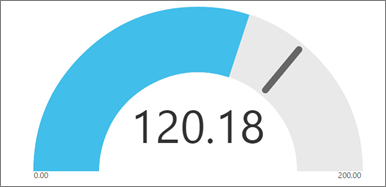

There are two sets of tick marks, minor and major. The scale displays labels and tick marks.

By default, this creates a smaller scale that is positioned inside the first scale. You can have multiple scales by right-clicking the gauge and selecting Add Scale. A gauge has at least one scale and one pointer. To change the gauge type, you must remove the gauge and re-add it to the design surface. Therefore, you cannot change the gauge type the same way you change a chart type. Unlike the chart types available in the Select Chart Type dialog box, the gauge types available in the Select Gauge Type dialog box are created by using a combination of gauge properties. This pointer can belong to the same scale, or you can add another scale and then associate the pointer with that scale. You can add multiple values to an individual gauge by adding another pointer. When grouping and filtering is applied, the gauge uses the pointer value to display the last group or row in the returned dataset.

You can add grouping to the gauge to view individual groups or individual rows on the gauge. The value of the pointer can use a different aggregate, or no aggregate. When you use numeric data, appropriate to add, the gauge uses the SUM function. Depending on the data type of the field, the gauge uses the SUM or COUNT aggregate. That value is attached to the pointer by using the Value property. By default, the gauge aggregates field values into one value that is shown on the gauge. Adding Data to a GaugeĪfter you add a gauge to the design surface, drag a dataset field to the gauge data pane. Linear gauge options: Horizontal, Vertical, Multiple Bar Pointers, Two Scales, Three Color Range, Logarithmic, Thermometer, Thermometer Fahrenheit/Celcius, and Bullet Graph. Radial gauge options: Radial, Radial with Mini Gauge, Two Scales, 90 Degrees Northeast, 90 Degrees Northwest, 90 Degrees Southwest, 90 Degrees Southeast,180 Degrees North, 180 Degrees South, 180 Degrees West180 Degrees East, and Meter. The linear gauge is horizontal and uses the thermometer pointer. The radial gauge is round and uses the needle pointer. The following illustrations show radial and linear gauges. For more information, see Indicators (Report Builder and SSRS). However, if you have to use a simple gauge in your report, you should consider using an indicator instead of a gauge. Other than these differences, the two gauge types are interchangeable. Because of its shape, this gauge type is useful for integrating into the table or matrix data regions to show progress data. The gauge pointers are often thermometers, but can be markers or bars. Linear gauges are rectangular, oriented horizontally or vertically, and resemble rulers. The gauge pointers are often needles, but can be markers or bars. Radial gauges are circular, or degrees of circular, and resemble speedometers. The key differences between the two types are the overall shape of the gauge and the available gauge pointers. The linear gauge is used to express the data as a temperature or scale value. The radial gauge is typically used when you want to express the data as a velocity. Reporting Services provides two gauge types: radial and linear. You can publish gauges separately from a report as report parts. The following illustration shows the basic elements of a single radial gauge in the gauge panel.įor more information about using gauges as KPIs, see Tutorial: Adding a KPI to Your Report (Report Builder). There are two types of gauges: radial and linear. Use multiple gauges in a single gauge panel to compare data between fields. Place a gauge inside a table or matrix to illustrate values inside each cell. Gauges can perform many tasks in a report:ĭisplay key performance indicators (KPIs) in a single radial or linear gauge. Inside a single gauge panel, you can create multiple gauges that share common functions such as filtering, grouping, or sorting. An individual gauge is always positioned inside a gauge panel, where you can add child or adjacent gauges. In paginated reports, a gauge data region displays a single value from your dataset. APPLIES TO: ✔️ Microsoft Report Builder (SSRS) ✔️ Power BI Report Builder ✔️ Report Designer in SQL Server Data Tools


 0 kommentar(er)
0 kommentar(er)
